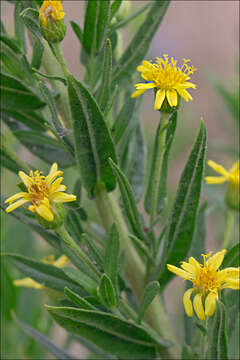Dittrichia-viscosa_4

Description:
Dittrichia viscosa (L.) Greuter, syn.: Erigeron viscosus L., Inula viscosa (L.) Aiton, Jacobaea viscosa (L.) MerinoSamphire, DE: Klebriger AlantSlo.: leplivi oman, lepljiva ditrihovkaDat.: Sept. 1. 2017Lat.: 44.83885 Long.: 14.73626Code: Bot_1085/DSC8828Habitat: Dirt road side and dry grassland, moderately inclined hill side, north aspect; sandstone ground; full sun, dry place; elevation 75 m (190 feet); average precipitations ~ 1.000 mm/year, average temperature 13-14 deg C, (Sub)Mediterranean phytogeographical region. Substratum: sandy soil.Place: Island Rab, northeast part of the island, next to dirt road south of Dubac bay, Kvarner bay, Adriatic Sea, Rijeka district, Croatia EC. Comment: Dittrichia viscosa is also one of many, many yellow flowering members of Daisy (Asteraceae = Compositae) family. It is distributed all around Mediterranean Sea, in Slovenia too. Not really an attractive plant for photography but once a popular medical plant, particularly esteemed in south part of Mediterranean and among Arab nations. Hardly know outside its native Mediterranean region the plant has been regarded for thousands of years as one of the most effective medical plant of the region. It is mentioned already in Bible's Old Testament. In the first century it was in broad use and Roman polyhistor Pliny the Elder (Gaius Plinius Secundus) wrote a detailed description and use of the plant. In 16th century it was officially used by Swiss military to heal wounds. Today it is still cultivated in Israel. It was used in very broad spectrum of ailments from gum disorder to hemorrhoids, wounds treatment, joints pain, respiratory problems, diabetes and more.The species is relatively easy to recognize by its stout, pyramidal growth of individual flowering stalks, numerous glandulous hair on all parts of the plant, which make the whole plant sticky, and very late blooming time. Hence it is one of the most important sources of honey for bees and other insects during the winter.Ref.:(1) D. Aeschimann, K. Lauber, D.M. Moser, J.P. Theurillat, Flora Alpina, Vol. 2., Haupt (2004), p 462.(2) www.inulav.com/Inula_Viscosa.html (accessed Oct. 15. 2017)(3) A. Martini et all., Mala Flora Slovenije (Flora of Slovenia - Key) (in Slovenian), Tehnina Zaloba Slovenije (2007), p 651. (4) I. Schnfelder, P. Schnfelder, Kosmos Atlas Mittelmeer- und Kanarenflora, Kosmos, (2002), p 216.
Included On The Following Pages:
- Life (creatures)
- Cellular (cellular organisms)
- Eukaryota (eukaryotes)
- Archaeplastida (plants)
- Chloroplastida (green plants)
- Streptophyta
- Embryophytes
- Tracheophyta (ferns)
- Spermatophytes (seed plants)
- Angiosperms (Dicotyledons)
- Eudicots
- Superasterids
- Asterids
- Asterales
- Asteraceae (composite family)
- Dittrichia (dittrichia)
- Dittrichia viscosa (Strong-smelling Inula)
This image is not featured in any collections.
Source Information
- license
- cc-by-nc-sa
- copyright
- Amadej Trnkoczy
- photographer
- Amadej Trnkoczy
- original
- original media file
- visit source
- partner site
- Flickr Group
- ID


